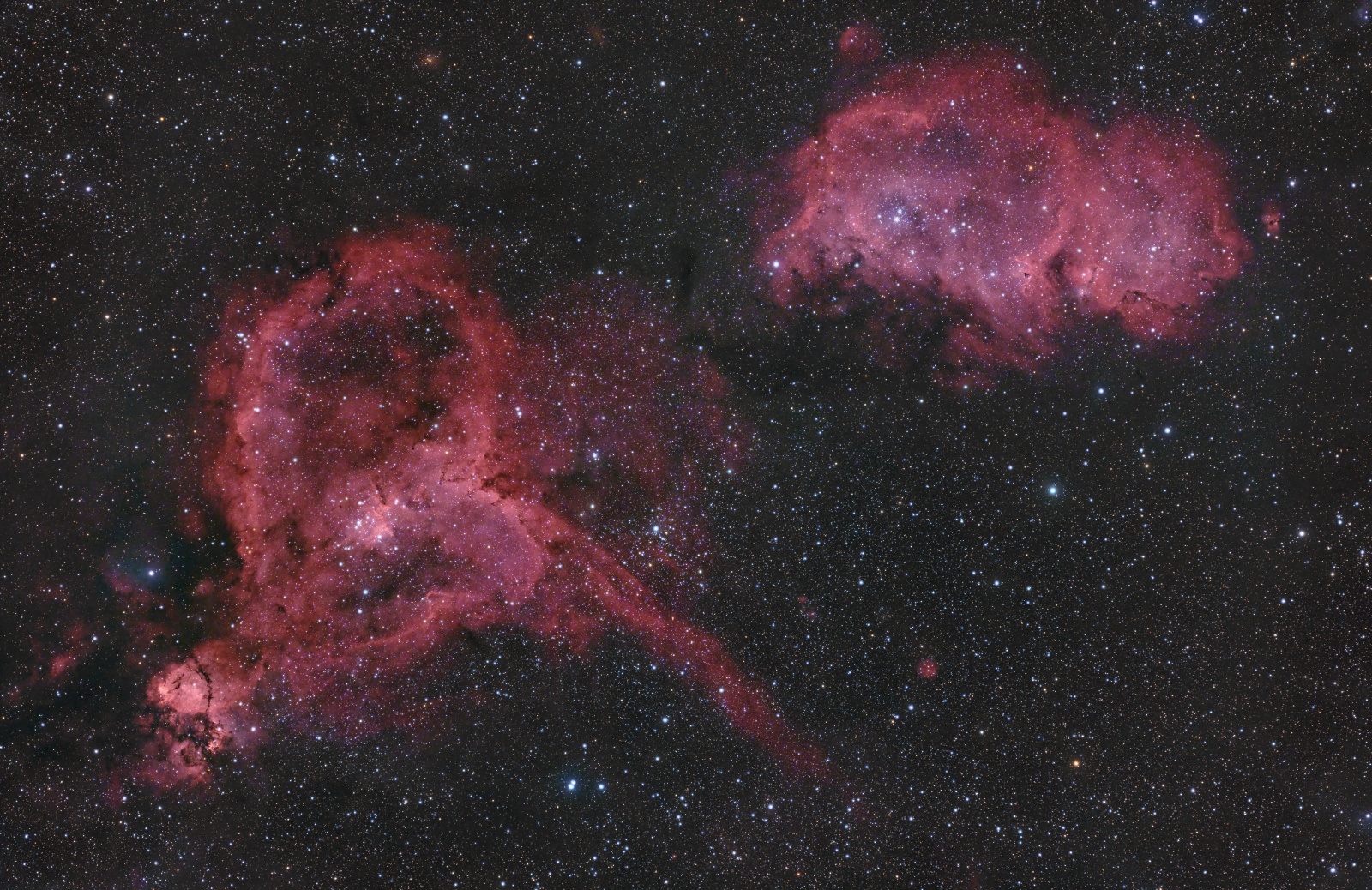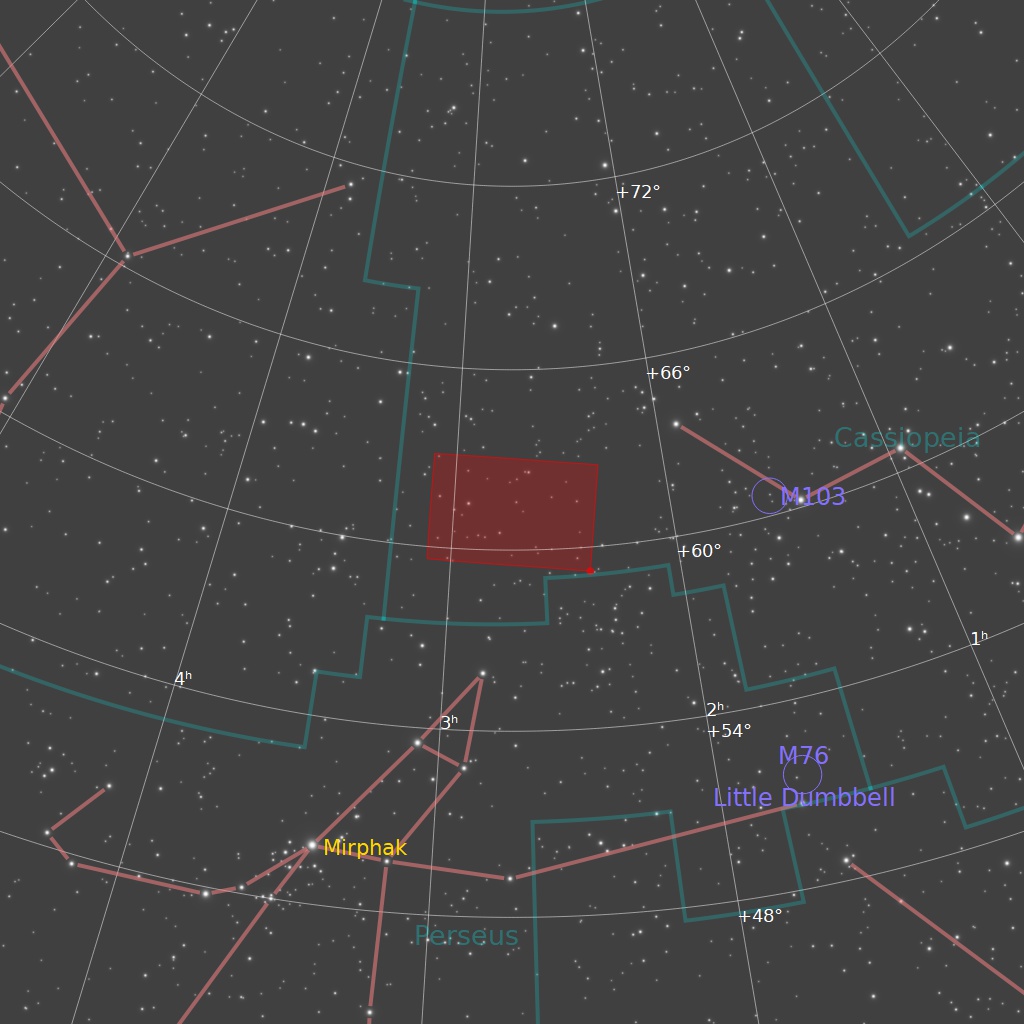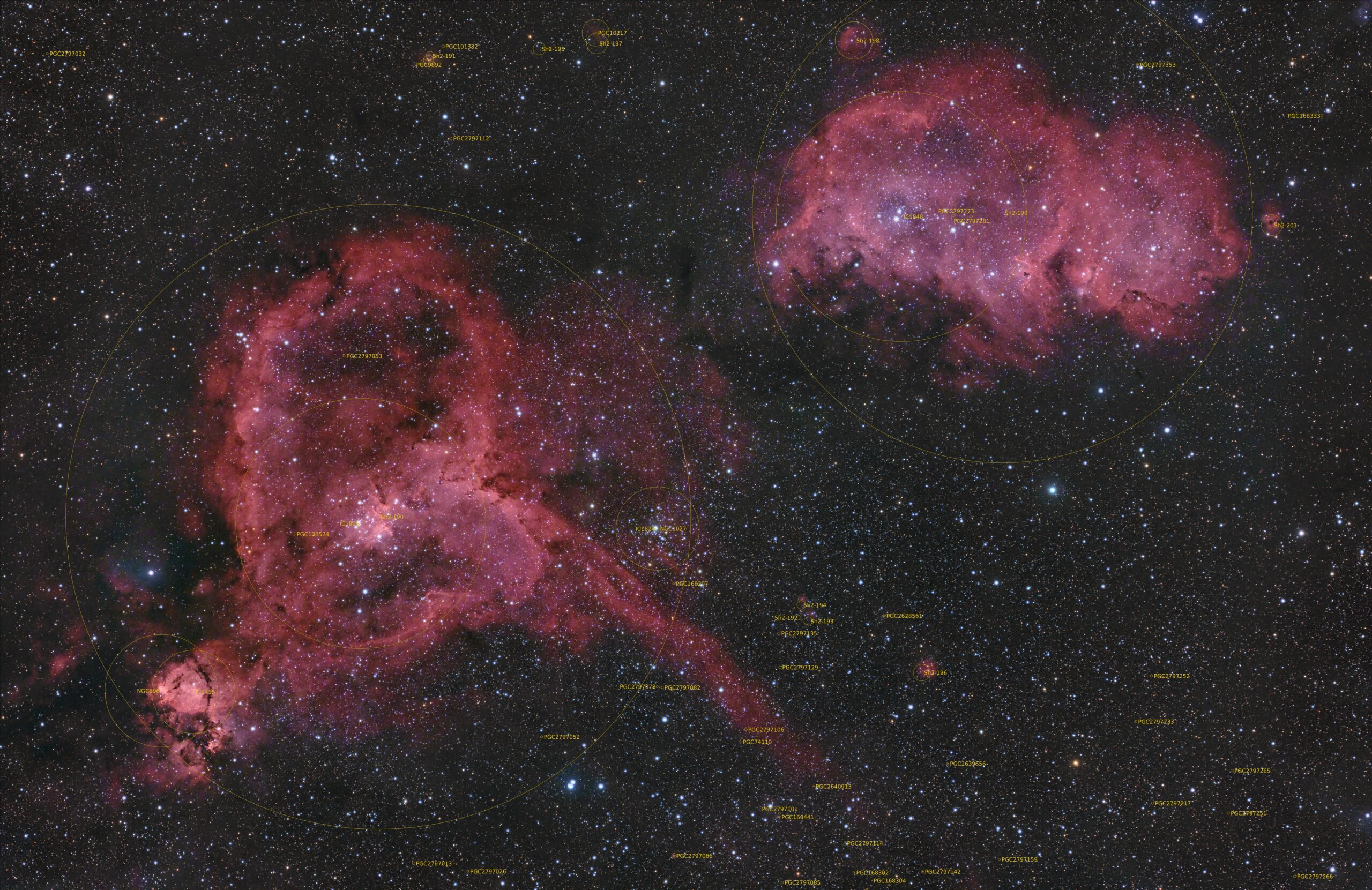Heart Nebula and Soul Nebula
 Click image for full size version
Click image for full size version
November 5, 2023
The Heart Nebula (lower left; IC 1805, Sh2-190), and Soul Nebula (upper right; IC 1848, Westerhout 5, LBN 667, Sh2-199) are large clouds of glowing gas. Both are in Cassiopeia and about 7,500 light years away in the Perseus arm of the Milky Way galaxy. The Heart Nebula is about 165 light years in diameter, with the Soul being a little smaller. To the lower left of the image is the Fishhead Nebula (IC 1795, NGC 896), while the open cluster Melotte 15 lies at the centre of the Heart nebula. That cluster is responsible for causing the hydrogen in this region to glow.
In addition to the main subjects of the image, there are numerous other catalogued objects in this shot that are interesting in their own right. I prepared an annotated image to help you navigate this busy field. Sh2-201 is the little patch of detached nebuolosity just right of IC 1848, and it shows some structure on close inspection. Sh2-198 appears above the left side of the Soul nebula. Sharpless 192, 193, 194 and 196 all lie to the right of the finger-like extension of the Heart nebula, just left of top centre of this image. Zoom in on the PGC objects. They are galaxies that are far in the background.
I shot almost the same field in 2019 with a bigger refractor and a dual-band narrowband filter. For the image above, I used the new Optolong L-Quad Enhance filger, which is a broadband filter that supresses light pollution. It’s interesting to compare the two results. The 2019 image shows a little more of the fainter parts of the emission nebulae, but the 2023 version has a more natural-looking colour to it and also reveals more of the dark nebulae between the two main subjects of the image. The 2019 used a scope with bigger aperture, faster focal ratio and more than double the exposure time.
Tekkies:
Takahashi FS-60CB scope with flattener at f/6.2 and QHY367C Pro one-shot colour camera with Optolong L-Quad Enhance Filter. Paramount MX, unguided. Equipment control with N.I.N.A. and PHD2. All pre-processing and processing in PixInsight. Acquired from my SkyShed in Guelph October 22-23, 2023. Average transparency and seeing, and little Moon.
117x5m chrominance = 9hr45m
Preprocessing: The WeightedBatchPreProcessing script was used to perform calibration, cosmetic correction, weighting, registration, local normalization, integration and Drizzle integration of all frames (CFA Drizzle checked, Scale=2x, Drop Shrink=0.9).
Gradient Removal: DynamicBackgroundExtraction was applied to the OSC master.
Colour Calibration: ColorCalibration was used to calibrate the OSC master.
Deconvolution: BlurXterminator was applied using an automatic PSF, star sharpening set to 0.10, and “Correct First” selected.
Star Removal: StarXterminator was used to remove the stars, with Unscreen selected.
Linear Noise Reduction: NoiseXterminator was applied with Amount=0.95 and Detail=0.5
Stretching: HistogramTransformation was applied to make a pleasing yet bright image. Approximate background level after stretch was 0.10
Nonlinear Processing
Nonlinear Noise Reduction: NoiseXterminator was applied with Amount=0.9 and Detail=0.25
Stretching: HistogramTransformation was applied a second time to adjust the black point and increase brightness and contrast. Approximate background level after stretch was 0.10
Contrast Enhancement: Using a mask to select the nebula, LocalHistogramEqualization was applied twice. A Contrast Limit of 1.5 and 1 iteration was used for each LHE application (scale 40, strength 0.35; scale 125, strength 0.35).
Sharpening: The same mask was used with MultiscaleMedianTransform to sharpen Layers 1 – 5 with strengths of 0.01, 0.03, 0.05, 0.03, and 0.02, respectively.
Dark Structure Enhancement: The DarkStructureEnhance script was applied with tdefault settings, except for amount = 0.25.
Stars-only steps: The stars-only image was stretched with HistogramTransformation. The stretch was slightly less aggressive than the sreen transfer function determined automatically by StarXterminator. CurvesTransformation CIE c* (colourfulness) slider was used to add colour saturation to the stars through a mask made by extracting the Luminance from the stretched stars-only image.
Star Restoration: PixelMath expression combine(starless, stars, op_screen()) was used to combine the starless and stars-only images created with StarXterminator.
Final Steps: Background, nebula and star brightness, contrast and saturation were adjusted in several iterations using CurvesTransformation with masks as required. The image was down-sampled by a factor of 2, which restored it to the original resolution. ICCProfileTransformation (sRGB IEC61966-2.1; Relative Colorimetric with black point compensation) was applied prior to saving as a jpg. The image was annotated with the AnnotateImage script. The finder chart was made using the FindingChart process.








Beautiful work!!
Gorgeous image, like always!